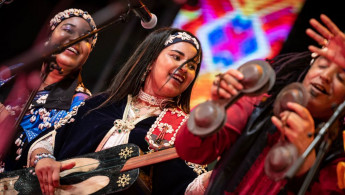Moroccan women shake up world of Gnaoua music
Young Moroccan women are bringing new and inclusive energy to the centuries-old art of Gnaoua, a spiritual musical repertoire traditionally reserved for men.
Also known as "tagnaouite", it gained worldwide recognition after it was listed by UNESCO as intangible cultural heritage in 2019.
"Why shouldn't women be part of this dynamic?" asked Asma Hamzaoui at the Gnaoua World Music Festival in Essaouira, a southern coastal city steeped in the musical tradition.
The 26-year-old Casablanca native is one of the first women to perform Gnaoua, which blends African rhythms with spiritual chants and poetry.
Her father, a Gnaoua master, initiated her into the artform at a young age.
"I've accompanied him to his evening gatherings since I was seven years old," recounted the young woman, who in 2012 formed the group "Bnat Timbouktou", or The Girls of Timbuktu.
"I gradually learned to play the guembri, a three-stringed lute made of camel skin. My father made sure that I learned as much as possible before I flew solo."
The all-female ensemble wowed the festival-goers – with Hamzaoui on vocals and the guembri, and four musicians on qraqeb steel castanets.
They played alongside the Amazones d'Afrique, another all-female group, from Mali.
'Feeds the spirit'
"It's exceptional to have women playing Gnaoua music, which shouldn't be reserved for men," said Hamza Tahir, a member of the audience. "They bring fresh air into this music."
Inspired by Bnat Timbouktou's success, rising star Hind Ennaira developed her passion for tagnaouite in her hometown of Essaouira.
Its fortified citadel on the Atlantic coast is a breeding ground for the mystical musical tradition, in which religious hymns invoke ancestors and spirits.
Originally practised by enslaved people and dating back at least to the 16th century, Gnaoua has gone from being practised largely in private gatherings, where therapeutic rituals accompanied the music, to public events such as concerts and festivals.
"The city of Essaouira is the cradle of tagnaouite," said Ennaira, who was taught to play the guembri by friends.
"It is beautiful heritage that feeds the spirit. It is important for young people to value it."
Ennaira put her own touch on the tradition by bringing in a guitarist and drummer to accompany the traditional ensemble.
"At first, there were some differences because they were not used to working with a woman," she said.
"But after some challenging exercises, they adapted to me and we became complementary."
'Jimi Hendrix' style
Yousra Mansour – the frontwoman of the band Bab L'bluz ("The Blues Gate"), which fuses Gnaoua, rock and blues – also encountered challenges entering the music scene.
"There were two constraints for me: first, the fact that this field is usually reserved for men, but also how we interpret traditional music," the musician told AFP.
"It is not very accepted or even tolerated by some of the stricter individuals.
"We replaced the bass with the guembri and the guitar with the awisha [a small guembri] and created a kind of 'power trio' in the style of Jimi Hendrix with reimagined traditional instruments," explained Mansour.
The 32-year-old vocalist passionately defends women's freedoms, saying that "as a woman, I have not had an easy life".
"There was a lack of women in this field. When I see Asma Hamzaoui or Hind Ennaira, they are magnificent," she said.
"It is not easy to evolve in a predominantly male universe, but we see changes emerging."





 Follow the Middle East's top stories in English at The New Arab on Google News
Follow the Middle East's top stories in English at The New Arab on Google News


